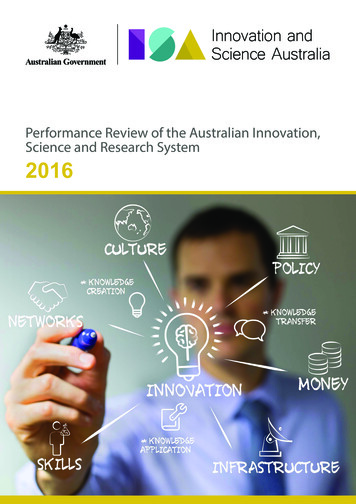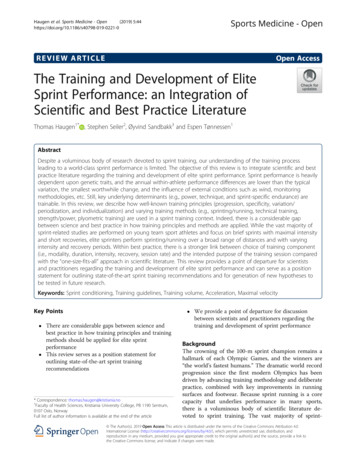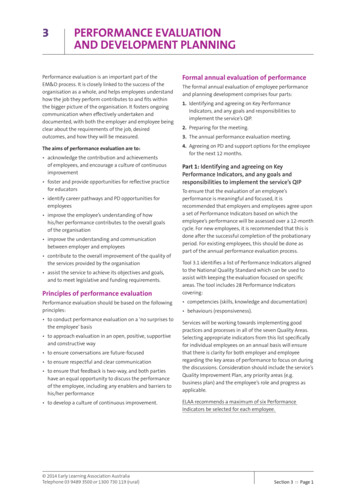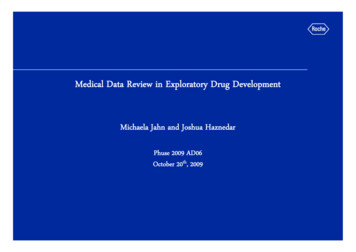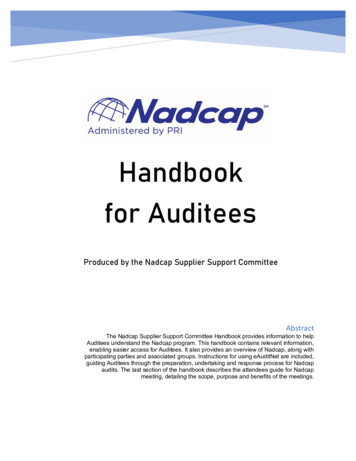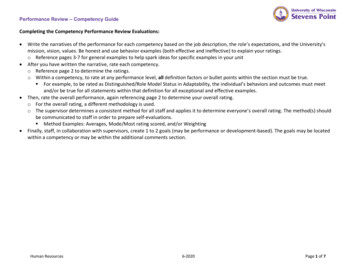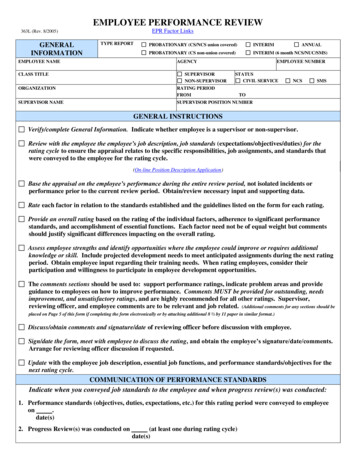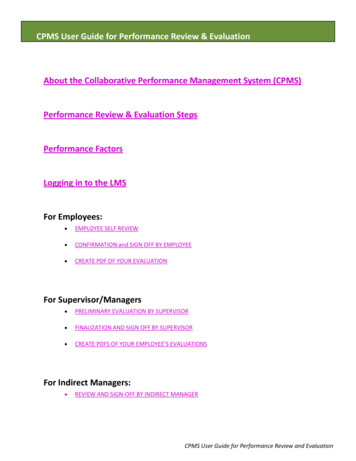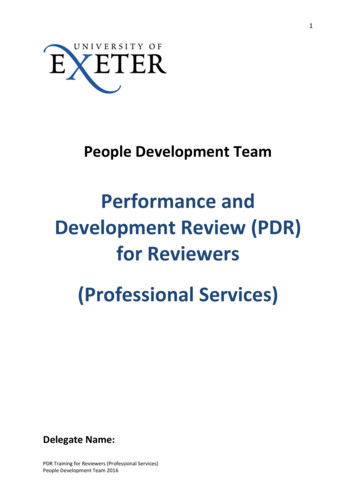
Transcription
1People Development TeamPerformance andDevelopment Review (PDR)for Reviewers(Professional Services)Delegate Name:PDR Training for Reviewers (Professional Services)People Development Team 2016
2ContentsPageIntroduction3Workshop Overview & Objectives4Appraising Performance – CIPD perspective5The Bigger Picture:- Performance Management Cycle- My Role in the Performance Management Cycle68PDR Roles and Responsibilities9PDR Preparation10Structuring a PDR Meeting11Setting and Reviewing Objectives- SMART Objectives- Objective Setting Self-Assessment121314Questioning, Listening and Adopting a Coaching Style- Asking the Right Questions- Questioning Techniques- Listening Skills- Coaching Techniques for Line Managers- Coaching-Style Questions151515161719Learning and Development20Giving and Receiving Feedback- Handling Weaker Aspects of Performance- Feedback Models212424Action Notes26Personal Action Planning27PDR Training for Reviewers (Professional Services)People Development Team 2016
3IntroductionThe People Development Team would like to welcome you to this workshop ‘Performance Development Review for Reviewers’.We want you to have a memorable experience during your workshop and to take away awide range of ideas, skills, tools and practical strategies that you can apply in your own workcontext – as well as meeting people from across the organisation to share and discuss yourexperiences.The Performance Development Review (PDR) is not just a set of processes. Used well, itoffers a constructive and flexible approach to reviewing your team members in a way thatinspires and motivates them to be the best that they can be. It also forms part of a wider,holistic approach to performance management.It is hoped that this workbook will be a valuable source of information in your role as a PDRreviewer.If there’s anything further the team can do to support your on-going development, pleasedon’t hesitate to get in touch - our contact details can be found on the back page.The People Development TeamPDR Training for Reviewers (Professional Services)People Development Team 2016
4Workshop OverviewThis workshop explores the purpose and mechanics of the PDR process and promotes acoaching style of review. It also considers the role of the PDR within the wider performancemanagement context.ObjectivesAs a result of attending this course, you will:-understand the purpose of PDRsfeel able to get the best out of a PDRbe confident in setting SMART objectivesfeel well-equipped to give meaningful feedbackunderstand when and how to use a coaching style and techniquesPersonal Learning ObjectivesUse the space below to record any personal learning objectives that you hope to fulfil eitherduring or after the workshop:PDR Training for Reviewers (Professional Services)People Development Team 2016
5Appraising PerformanceExtract from Chartered Institute of Personnel and Development (CIPD) factsheet onperformance heets/performance-appraisal.aspxWhat is performance appraisal?Performance appraisal (or performance review) is a process for individual employees andthose concerned with their performance, typically line managers, to discuss theirperformance and development, as well as the support they need in their role. It’s used toboth assess recent performance and focus on future objectives, opportunities and resourcesneeded.Relationship with performance managementWhile performance appraisal is an important – and often contested – part of performancemanagement, in itself it is not performance management: rather, it’s one of a range of toolsthat can be used to manage performance.Performance management is a holistic process bringing together many activities thatcollectively contribute to the effective people management and organisationalperformance. The process is strategic, in that it’s about broader issues and long-term goals,and integrated in that it links various aspects of the business, people management,individuals and teams.Role of line managersCIPD research stresses the importance of a positive relationship between individuals andline managers. Carried out sensitively, the performance appraisal is an important vehicle indeveloping and maintaining this relationship.Elements of the appraisal processThe five key elements of performance appraisal are:1. Measurement – assessing performance against agreed targets and objectives, aswell as behaviours and attitudes against espoused values.2. Feedback – providing information to individuals on their performance and progressand on what’s required to perform well in the future, particularly in view of anychange programme and evolution of roles.3. Positive reinforcement – emphasising what has been done well, offeringconstructive criticism about what might be improved, drawing out the importance ofhow things are done, as well as what is done, and ensuring effort is directed at valueadding activities.4. Open exchange of views – a frank exchange of views about what has happened, howappraisees can improve their performance, the support they need from theirmanager to achieve this and their aspirations for their future career.5. Agreement – jointly coming to an understanding by all parties about what needs tobe done to improve and sustain performance generally and overcome any issuesraised in the course of the discussion.PDR Training for Reviewers (Professional Services)People Development Team 2016
6Performance Management CycleFully realised, performance management is a holistic process bringing together many of theelements that make up the successful practice of people management. The cycle belowhighlights some of the key elements of effective performance management. CoachingMentoringDelegatingSupporting careerprogression Understanding organisationvision, strategy and values Understanding business areastrategy Facilitating objective setting Agreeing standards and isingPerformanceManagingPerformance Holistic review Documentation Agreeing overall performancelevels and action requiredPDR Training for Reviewers (Professional Services)People Development Team 2016 Monitoring against predetermined standards Recognising and managingpoor performance Recognising, rewarding andsustaining good performance
7Performance planning involves considering broad issues and long-term goals ofthe business and translating, with discussion and contribution from your employee, intoclearly defined work objectives. It is also about ensuring your direct reports have the skillsand ability and to deliver on these expectations, and if gaps exist encouraging goal settingand supporting learning and development.Managing performance describes the process of continually monitoringperformance against pre-determined standards and recognising and managing poorperformance and also reinforcing and rewarding good performance.Appraising performance is an opportunity for individual employee andmanager to engage in a dialogue about performance and development, as well as thesupport required from the manager. This is often in a private setting and discussions arerecorded and documented. Performance appraisals usually review past actions andbehaviour and so provide an opportunity to reflect on past performance. To be successfulthey should also be used as a basis for making development and improvement plans andreaching agreement about what should be done in the future (considering the ‘PerformancePlanning’ factors).Developing performance involves regular feedback to an employee about theirperformance and support to help develop existing and new skills and knowledge. Amanager can facilitate this through, for example, coaching/mentoring and discussing alloptions available. Unless there is continuous development of individuals and teams,performance will not improve.PDR Training for Reviewers (Professional Services)People Development Team 2016
8My Role in the Performance Management CycleIn your role as a line manager / supervisor / reviewer, identify what you are already doingthat contributes to the different stages of the performance management cycle. Alsoconsider what you could start doing when you get back to ingPerformanceDevelopingPerformancePDR Training for Reviewers (Professional Services)People Development Team 2016
9PDR Roles & ResponsibilitiesPDR is: an opportunity for reviewer and reviewee to reflect and evaluatea scheme of regular, well-planned meetingsan opportunity for open discussion between reviewer and reviewee in the followingareas:- job performance- strengths- future potential and career progression- setting of objectives- developmental needsa review and planning discussionthe reviewee’s meeting, not the reviewer’sPDR aims to: maintain and encourage high standards of performancefacilitate developmentincrease employee motivationidentify and develop areas which will enhance the reviewee’s potential and careerReviewer’s role: create a supportive environment to promote an open discussionrecognise achievements and celebrate successesstrengthen relationships and improve team workinghelp individuals focus on their priorities for the coming yearidentify training and development needsget useful feedback from the revieweeshare feedback with the revieweemanage the reviewee’s expectationscontribute to the motivation, wellbeing and retention of employeesWhat responsibilities do reviewee’s have? Reflection Question: Are your reviewees clear about their responsibilitieswithin the process? How do you know?PDR Training for Reviewers (Professional Services)People Development Team 2016
10PDR PreparationReviewer: Advance PreparationReviewer: Meeting PreparationAhead of the meeting the reviewer should consider:Clarify well in advance of PDR meetings thespecific process within your department: the reviewee’s previous PDR and objectives- Local protocol the reviewee’s job description- By whom performance over the whole period and refer- Whereto any notes made (e.g. from 1:1 meetings)- Time-scale feedback to be given at the meeting and the- Approximate length of meetingevidence that will be used to support itFamiliarise yourself with the University of your own observations and experience ofExeter procedures and documentation,working with the revieweewhich can be found here: other information form colleagues, clients, etchttp://www.exeter.ac.uk/staff/development/(if appropriate)your/pdr/ Explain to reviewees how PDRs will becarried out, giving an indication of thetimescale and an explanation of what isinvolved. Emphasise the benefits of PDR.Remember that some employees mayfind PDR a worrying time – encourageopen discussions regarding any concernsat an early stage.Making PDR objectives a regulardiscussion point throughout the year canalso be beneficial.PDR Training for Reviewers (Professional Services)People Development Team 2016 additional information e.g. projects completed,reports, performance data, metrics, etchaving specific examples of work, especially ifyou intend to refer to it at the PDR meetingfactors that have affected performance, bothwithin and outside the individual’s controlpoints for discussion on the possible actionsthat could be taken by both parties to improveperformancethe extent to which any agreed developmentplans from the previous PDR have beenimplementedpotential directions the individual’s careermight takepossible objectives for the next review periodReviewee: Meeting PreparationBoth the reviewer and reviewee areresponsible for ensuring that the PDR isuseful and productive. It is important toencourage the reviewee to prepare for thediscussion, as well as doing this yourself.Reviewees should consider: what they have achieved during thereview period, with examples andevidence any examples of objectives notachieved, with explanations what they most enjoy about the joband how they might want to developthe role any aspect of the work in whichimprovement is required and how thismight be achieved their learning and development needs,with reasoning to support their casefor specific training what level of support and guidancethey require from their manager their aspirations for the future, both inthe current role and in possible futureroles possible objectives for the next reviewperiod
11Structuring a PDR MeetingIf you are new to conducting PDRs or just want to refresh what you currently do, thechecklist below provides some ideas as to what you may wish to cover.This is just a starting point for you to adapt and tailor to meet your own needs and those ofyour reviewees (the PDR form will also help you to structure the meeting).Beginning Welcome reviewee, establish rapport Explain and discuss puspose of PDR (if not done pior to meeting) Agree / revise agenda Remind reviewee how long you've set aside Remind reviewee of confidential nature of PDR and the documentationinvolved Reinforce fact that you want to hear their views Explain it's a joint planning sessionMiddle - exploring the issues Introduce Discuss Check decision is clearMiddle (continued) - discussion prompts Discussion of last year's overall objectives Key result areas - reviewee's performance Reviewee's strengths (their opinion first and then yours) Challenges / barriers Training and development needs Reviewee's career aspirations Setting new objectivesEnding Consult notes to review and summarise the decisions Ensure agreement has been reached Discuss and agree timescale for action Decide how decisions will be followed up and, if appropriate, monitored Finish on a positive notePDR Training for Reviewers (Professional Services)People Development Team 2016
12Setting and Reviewing ObjectivesThe principle of having clear, unambiguous objectives is a very simple, yet critical one: If you know where you are heading you are more likely to get there. You will also know when you arrive. Your achievements will be clear to yourself and others and you’ll know when andwhat to celebrate. In addition, for most people, clear and agreed objectives are extremely motivatingand empowering.An objective is essentially a goal or a measurable step within a designated period of time.Employee performance is then compared against this objective, with the achievement resultingin something that adds value to the business and improves efficiency.Objectives can be expressed as: Targets – quantifiable results to be attained, which can be measured in such terms asoutput, sales, levels of service delivery and cost reductionTasks/Projects – to be completed by a specific date and to specific standards to achievedefined resultsObjectives can be individualised and specific to the employee or collective, for a wholedepartment or the entire business.Drafting ObjectivesDefining objectives is an essential part of the PDR process. There are a number of stagesinvolved for employees:a) Identify key areas of responsibility – think about particular priorities for the comingperiod.b) Consider what result is realistic to achieve for each area of responsibility during thereview period.c) Think about how to measure achievement of an objective and then set standards basedon such things as quality, cost and deadlines.Guidelines for Setting Objectives Agree objectives jointly Agree how the objective will bemeasured Agree timescales Ensure objectives are achievable butchallengingPDR Training for Reviewers (Professional Services)People Development Team 2016Benefits of Objective Setting Provides specific targets for theemployee to achieve in support ofbusiness challenges It states how performance is going tobe measured It provides direction Helps to focus on a specific task
13 Consider corporate objectives and theneeds of the businessConsider how the employee will goabout tackling the objectiveHave objectives related to personaldevelopmentEnsure objectives can be reviewedregularlyHave support available when needed Helps to prioritise tasksAllows reviews to be undertaken andperformance to be discussedEnables success to be measuredSMART is an acronym that can be used to help ensure that effective objectives or goals are set.SpecificMeasurableObjectives are clear and well-defined. This helps both the employeeand the manager, as the employee knows what is expected of themand the manager is able to monitor and assess actual performanceagainst the specific objectives.You should be able to measure whether you are meeting theobjective or not. Progress towards objectives often needs to be to bemonitored whilst work is under way. It is also very useful to knowwhen that work has been done and the objectives are completed. Ameasurable objective achieves this end.Achievable /AgreedThe objective set is challenging but within reach of a competent andcommitted person. When looking at objectives, the person may notbe able to achieve it for various reasons, including not having enoughresources (computers, employees, etc.), not having access to keypeople and not having management support. Achievable objectivesensure that everything is in place.RelevantObjectives are relevant to the departmental goals and thereforealigned to corporate goals.Time BoundDescriptions of objectives should also include timescales of what isrequired by when. This may also include details of delivery, stating (ifrelevant) when objectives are to be completed. Giving a time scaleensures that the objectives are not stretched out over anunreasonably long or to tight a timescale.PDR Training for Reviewers (Professional Services)People Development Team 2016
14Objective Setting Self-AssessmentTake a few moments to review your own approach to objective setting, and where theremay be room for improvement.1Not at all2To some extent3Mostly4Always5Not applicable1I actively involve all my team in setting objectives123452I agree challenging targets with my team members123453I regularly discuss progress towards objectives set123454I ensure that my own and my team’s objectives arespecificI ensure that my own and my team’s objectiveshave clear measuresI ensure my own and my team’s objectives areachievable and relevantI ensure that my own and my team’s objectives areexpressed as outcomes, not simply a list of activitiesI ensure that my own and my team’s objectiveshave associated deadlinesI ensure that we recognise and celebrateachievement of our objectivesI create visible measures of progress towards teamobjectivesI identify and help overcome blocks to progresstowards objectivesI demonstrate clear links between organisationaland individual goals / objectivesI set aside quality time and review objectives withmy team 45123455678910111213Which of the above behaviours are my strengths?Which of the above behaviours are my weaknesses?Which of the behaviours do I want to develop and how will I do this?PDR Training for Reviewers (Professional Services)People Development Team 2016
15Questioning, Listening and Adopting a Coaching StyleAsking the right questionsIt is important for reviewers to ask both open and probing questions.Open questions are general rather than specific; they enable people to decide how theyshould be answered and encourage them to talk freely. Examples include: How do you feel things have been going?How do you see the job developing?How do you feel about that?Tell me, why do you think that happened?Probing questions dig deeper for more specific information on what happened or why. Theyshould indicate support for the individual’s answer and encourage reviewees to providemore information about their feelings and attitudes, while they can also be used to reflectback to the individual and check information. Examples would be: That’s very interesting. Tell me more about ?To what extent do you think that ?Have I got the right impression? Do you mean that .?Questioning Tech
performance against pre-determined standards and recognising and managing poor performance and also reinforcing and rewarding good performance. Appraising performance is an opportunity for individual employee and manager to engage in a dialogue about performance and devel

